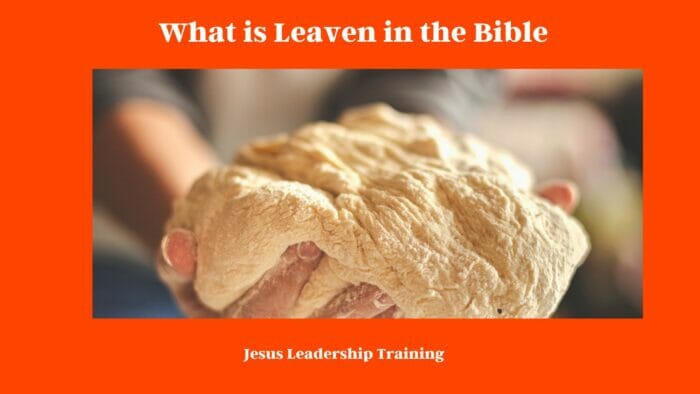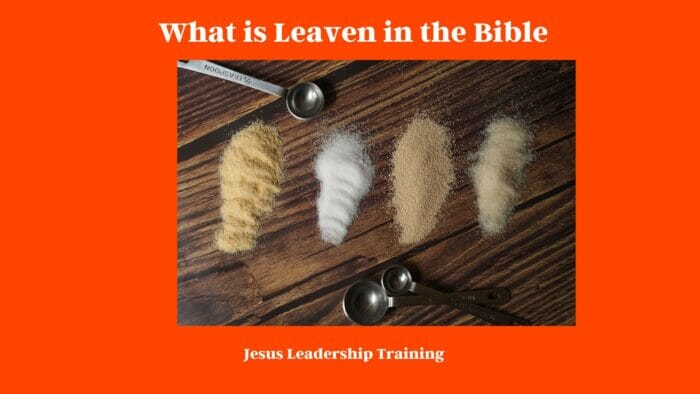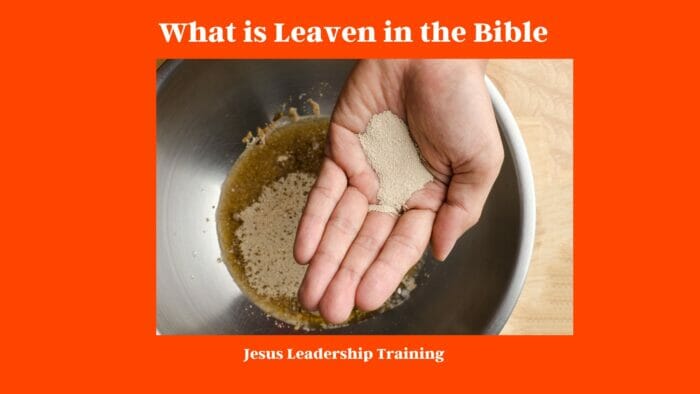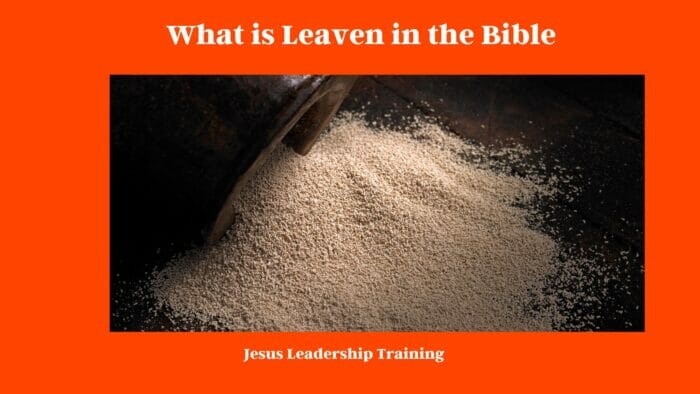Leaven Definition in the Bible ? Unraveling the enigmatic metaphorical nuances of the Bible can sometimes feel like trying to find a needle in a haystack. Among the various symbols utilized, “leaven” is one that recurs frequently, often bearing a profound, multi-layered significance. But what is leaven in the Bible, really? It’s not just a question of identifying the physical substance, but of uncovering the symbolic meaning behind its repeated appearances. So, hold onto your hats, folks, because we’re about to dig into this deep and mystifying topic!
Table of Contents
Leaven Definition in the Bible
Leaven, in its most fundamental definition, is a substance added to dough to make it rise. It is used in baking to produce the fluffy and light texture we associate with many baked goods. In the Biblical context, however, leaven assumes a more symbolic role, acting as a potent metaphor in various passages.
The term “leaven” is used throughout the Bible to symbolize sin, evil, and corruption. This is a common theme in the Gospel, and the symbolism of leaven has been used to represent sin in the Bible since the time of the Old Testament. While leaven has been used to symbolize sin in the Bible, it has also been used to represent good works and spiritual growth. In this blog, we will explore the use of leaven as a symbol of sin and evil in the Bible, as well as its use for spiritual growth and good works.

Table Listing the Symbolism of Leaven in the Bible
The term ‘leaven’ appears several times in the Bible, primarily in the Old and New Testaments. Its symbolism is crucial to understanding various biblical teachings. The following table outlines the primary interpretations of leaven’s symbolism in the Bible:
| Scripture Reference | Symbolism of Leaven |
|---|---|
| Exodus 12:14-20 | In the context of the Passover, leaven symbolizes the influence of Egypt (sin) that the Israelites were to leave behind during their exodus. The Feast of Unleavened Bread symbolized a break with the past and a new beginning. |
| Leviticus 2:11 | Leaven is forbidden in offerings made by fire to the Lord, symbolizing that our service to God should be sincere and truthful, free from the ‘leaven’ of hypocrisy and evil. |
| Matthew 16:6-12 | Jesus cautions his disciples to beware the leaven (teaching) of the Pharisees and Sadducees. Here, leaven symbolizes false teachings and religious hypocrisy. |
| Matthew 13:33 | In the parable of the leaven, Jesus uses leaven to describe the kingdom of heaven, symbolizing how a small bit of leaven can influence a large amount of dough, just as a small bit of God’s truth can spread and have a large influence. |
| 1 Corinthians 5:6-8 | Paul uses leaven as a symbol for malice and wickedness. Unleavened bread symbolizes sincerity and truth. |
| Galatians 5:7-9 | Paul again refers to leaven as a metaphor for influence, particularly of false teaching that can permeate a group or individual, leading them away from the truth of the gospel. |
Please note that the context of the scripture is essential when considering these symbolic interpretations. The symbolism of leaven may vary depending on the specific context in which it is mentioned.
The Gospel and What is Leavened
Leaven is a term used to refer to a substance that is used to cause dough to rise. In the Bible, leaven was most commonly used to make bread. In the Old Testament, leaven was often used in sacrifices and offerings as a symbol of holiness. In Matthew 16: 6-12, Jesus speaks about leaven and warns his disciples to beware of the leaven of the Pharisees and the leaven of Herod. In this passage, leaven is used to represent the corrupting teachings of the Pharisees and Herod.

Symbolic of Sin and Evil: Leaven in the Bible
Leaven has been used throughout the Bible to represent sin and evil. In the Old Testament, leaven was often used to symbolize the evil of idolatry. In the New Testament, Jesus equates leaven with evil, warning his disciples to beware of the leaven of the Pharisees and the leaven of Herod. This is one of the clearest instances in which leaven is used to represent sin in the Bible.
Negative influences of Leaven in the Bible
In the Bible, leaven often symbolizes negative influences or elements. Its properties of fermentation and spreading are used metaphorically to depict how these harmful influences can permeate and affect individuals and communities. The following table outlines the negative influences of leaven in the Bible:
| Scripture Reference | Negative Influence of Leaven |
|---|---|
| Exodus 12:14-20 | Here, leaven is associated with the past sins and influences of Egypt. Its removal during the Feast of Unleavened Bread signifies the need to remove sin from our lives. |
| Leviticus 2:11 | The prohibition of leaven in offerings made by fire to the Lord suggests its association with corruption and impurity. Our offerings to God should not be tainted with such negative elements. |
| Matthew 16:6-12 | Jesus warns his disciples about the leaven of the Pharisees and Sadducees. Here, leaven represents the false teachings and hypocrisy of religious leaders that can mislead followers. |
| 1 Corinthians 5:6-8 | In this passage, leaven represents malice and wickedness. Paul urges the Corinthians to cleanse out the old leaven and become a new, unleavened batch, free from evil. |
| Galatians 5:7-9 | Paul uses leaven to symbolize a negative influence that hinders obedience to the truth. He warns that a little leaven leavens the whole batch of dough, illustrating how a small amount of negative influence can impact a large group. |
Understanding these symbolic interpretations can enrich our understanding of the biblical teachings and help us reflect on our spiritual journey.

Positive influences of Leaven in the Bible
While leaven (or yeast) in the Bible often symbolizes negative influences, it also has positive symbolic meanings in a few instances. The primary instance of this positive symbolism comes from Jesus’ parables where the kingdom of heaven is likened to leaven. The following table outlines the positive influences of leaven in the Bible:
| Scripture Reference | Positive Influence of Leaven |
|---|---|
| Matthew 13:33 | In the Parable of the Leaven, Jesus uses leaven as a metaphor for the Kingdom of Heaven. Here, leaven signifies the powerful and pervasive growth of God’s Kingdom. Just as a small amount of leaven can make an entire lump of dough rise, so too can the Kingdom of Heaven grow and influence the world starting from small, humble beginnings. |
| Luke 13:20-21 | This scripture is another instance of the Parable of the Leaven. It reiterates the concept that the Kingdom of God, though it starts small like leaven in dough, eventually permeates and transforms everything. |
The positive representation of leaven in these passages reminds us of the transformative power of God’s Kingdom and the impact that even small acts of kindness and faith can have when infused with the power of God’s love.
The New Testament and Leaven in Scripture
The New Testament also uses leaven to symbolize sin and evil. In 1 Corinthians 5:6-8, Paul speaks of the leaven of malice and wickedness, and he warns the Corinthians to purge out the old leaven in order to keep the feast of the Passover. In this passage, leaven is used to represent sin and evil, and Paul urges the Corinthians to purge out the old leaven in order to keep the feast of the Passover.
What is Leavened According to Biblical Scriptures?
The Bible is clear about what is leavened. In the Old Testament, leaven was used to make bread, and it was also used in certain offerings and sacrifices as a symbol of holiness. In the New Testament, leaven is used to represent sin and evil. In 1 Corinthians 5:6-8, Paul speaks of the leaven of malice and wickedness, and he warns the Corinthians to purge out the old leaven in order to keep the feast of the Passover.
Uses of Yeast in Bible Times
Yeast, or leaven, was commonly used in the times of the Bible and had a variety of uses, both literal and symbolic. The following table outlines these uses as mentioned in different passages of the Bible:
| Use | Biblical References | Details |
|---|---|---|
| Bread Making | Exodus 12:15, 19; Leviticus 7:13; Matthew 13:33 | Yeast was used to leaven bread, causing it to rise during baking, resulting in soft, fluffy loaves. The Israelites were commanded to remove all yeast from their houses during the Feast of Unleavened Bread, signifying the haste of their departure from Egypt. |
| Symbol of Sin and Corruption | 1 Corinthians 5:6-8; Galatians 5:9 | Yeast’s ability to permeate and change dough was often used metaphorically to represent the pervasive and corrupting nature of sin. Paul warns the Corinthians that a little yeast leavens the whole batch of dough, urging them to remove the old yeast of malice and wickedness. |
| Symbol of the Kingdom of God | Matthew 13:33; Luke 13:20-21 | Jesus uses the parable of yeast to illustrate the Kingdom of God. Just as a little yeast makes the whole dough rise, the Kingdom of God starts from small beginnings but eventually permeates and transforms everything. |
| Symbol of Hypocrisy | Luke 12:1 | Jesus warned His disciples against the “yeast of the Pharisees,” which He described as hypocrisy. This was a metaphor for the influence the Pharisees had on the people, spreading their religious pretensions and falsehoods. |
| Offerings and Feasts | Leviticus 7:13, 23:17 | Yeast was used in offerings, particularly in the Feast of Weeks (Pentecost), where two loaves of leavened bread were waved as a thanksgiving for the Lord’s provision. However, yeast was not used in burnt offerings or during the Feast of Unleavened Bread. |
It’s interesting to see how the use of yeast in biblical times extended beyond simple culinary applications to deep spiritual metaphors, offering us insights into the culture, practices, and teachings of that era.
Leaven Considered in the ASV, NAS, RSV, and WBS
The American Standard Version (ASV), New American Standard Bible (NASB), Revised Standard Version (RSV), and World Bible Society (WBS) all use leaven to symbolize sin and evil in the Bible. In the ASV, leaven is used to symbolize sin and wickedness in 1 Corinthians 5: 6-8, while the NASB, RSV, and WBS all use leaven to represent sin and wickedness in the same passage.
Uses of Yeast in the 20th Century
Yeast, a microscopic fungus consisting of single oval cells, has been used in numerous ways throughout the 20th century and continues to be a vital part of many processes today. Here is a table listing some of the primary uses of yeast during the 20th century:
| Use | Details |
|---|---|
| Baking | Yeast has been used extensively in baking bread and pastries. It ferments the sugars present in the dough, producing carbon dioxide and ethanol, leading to the dough’s rising. |
| Alcohol Production | Yeast is crucial in the production of alcoholic beverages like wine, beer, and spirits. It ferments the sugars in the base ingredients (grains, grapes, etc.), producing alcohol. |
| Biofuel Production | In the late 20th century, yeast started to be used in the production of biofuels such as ethanol. Yeast ferments biomass-derived sugars to produce bioethanol. |
| Scientific Research | The yeast species Saccharomyces cerevisiae has been a popular model organism in cell biology and genetics research due to its simple structure, rapid growth, and the ease of manipulating its genes. |
| Food and Health Supplements | Yeast, particularly nutritional yeast, has been used in the 20th century as a food additive and a dietary supplement, especially popular among vegetarians and vegans for its high content of protein, vitamins (especially B vitamins), and minerals. |
| Animal Feed | Yeast, especially brewer’s yeast, is used in animal feeds as a source of protein, vitamins, and minerals. |
| Biotechnology | In the late 20th century, with the rise of biotechnology, genetically modified yeasts have been used to produce human proteins like insulin and vaccines. |
These applications of yeast have significant impacts on food, drink, health, science, and more, reflecting yeast’s importance in various aspects of human life and industry.
Sourdough Starter: Leavened Leaven in Bread
Sourdough starter is a type of leavened bread that has been around since ancient times. It is made by combining a mixture of flour, water, and yeast, which ferments over time to create a sourdough starter. The starter is then added to bread dough to create a leavened bread. Sourdough starter is a type of leavened bread that is still used today, and it has been used to symbolize sin in the Bible.
Jesus and Leaven: What Does the Bible Say?
In Matthew 16: 6-12, Jesus speaks about leaven and warns his disciples to beware of the leaven of the Pharisees and the leaven of Herod. In this passage, leaven is used to represent the corrupting teachings of the Pharisees and Herod. Jesus also uses leaven to symbolize sin in the parable of the leaven in Luke 13:20-21. In this parable, Jesus speaks of a woman who took a bit of leaven and hid it in three measures of meal, and he talks about how leaven causes the whole batch of meal to be leavened.
Leaven as a Symbol of Sin in the Bible
Leaven has been used throughout the Bible to symbolize sin and evil. In the Old Testament, leaven was often used to symbolize the evil of idolatry. In the New Testament, Jesus equates leaven with evil, warning his disciples to beware of the leaven of the Pharisees and the leaven of Herod. In 1 Corinthians 5:6-8, Paul speaks of the leaven of malice and wickedness, and he warns the Corinthians to purge out the old leaven in order to keep the feast of the Passover.
The New Testament and Leaven in Scripture
The New Testament also uses leaven to symbolize sin and evil. In 1 Corinthians 5: 6-8, Paul speaks of the leaven of malice and wickedness, and he warns the Corinthians to purge out the old leaven in order to keep the feast of the Passover. In this passage, leaven is used to represent sin and evil, and Paul urges the Corinthians to purge out the old leaven in order to keep the feast of the Passover.
Leaven as Used in Jesus’ Parables
Jesus uses leaven in several of his parables to symbolize sin and evil. In the parable of the leaven in Luke 13:20-21, Jesus speaks of a woman who took a bit of leaven and hid it in three measures of meal, and he talks about how leaven causes the whole batch of meal to be leavened. In the parable of the mustard seed in Matthew 13:31-32, Jesus speaks of a man who planted a mustard seed in his field, and he talks about how the mustard seed grows into a great tree where the birds of the air can nest in its branches. In this parable, Jesus uses leaven to symbolize the spread of sin in the world.
Leavened Bread in the Bible: What is it?
Leavened bread is a type of bread that has been made using a leavening agent, such as yeast, to cause the dough to rise. Leavened bread has been used since ancient times, and it is still used today. In the Bible, leavened bread is used to symbolize sin, as in the parable of the leaven in Luke 13:20-21. In this parable, Jesus speaks of a woman who takes a bit of leaven and hides it in three measures of meal, and he talks about how leaven causes the whole batch of meal to be leavened.
The Meaning of Leaven in the Bible
The meaning of leaven in the Bible is clear. Leaven is used throughout the Bible to symbolize sin, evil, and corruption. In the Old Testament, leaven was often used to symbolize the evil of idolatry. In the New Testament, Jesus equates leaven with evil, warning his disciples to beware of the leaven of the Pharisees and the leaven of Herod. In 1 Corinthians 5:6-8, Paul speaks of the leaven of malice and wickedness, and he warns the Corinthians to purge out the old leaven in order to keep the feast of the Passover.
Leaven and the Symbols of Sin in the Gospel
The Gospel of Jesus Christ is filled with symbols and metaphors of sin and evil. Leaven is used throughout the Bible as a symbol of sin and evil. In Matthew 16: 6-12, Jesus speaks about leaven and warns his disciples to beware of the leaven of the Pharisees and the leaven of Herod. In 1 Corinthians 5:6-8, Paul speaks of the leaven of malice and wickedness, and he warns the Corinthians to purge out the old leaven in order to keep the feast of the Passover.
Using Leaven in the Bible: New Testament Teachings
The New Testament contains teachings about how to use leaven in the Bible. In 1 Corinthians 5:6-8, Paul speaks of the leaven of malice and wickedness, and he warns the Corinthians to purge out the old leaven in order to keep the feast of the Passover. In this passage, Paul urges the Corinthians to purge out the old leaven in order to keep the feast of the Passover and to remain pure and holy.
Leaven as a Symbol of Evil in the Bible
Leaven has been used throughout the Bible to represent sin and evil. In the Old Testament, leaven was often used to symbolize the evil of idolatry. In the New Testament, Jesus equates leaven with evil, warning his disciples to beware of the leaven of the Pharisees and the leaven of Herod. In 1 Corinthians 5:6-8, Paul speaks of the leaven of malice and wickedness, and he warns the Corinthians to purge out the old leaven in order to keep the feast of the Passover. Leaven is a powerful symbol of evil in the Bible, and it serves as a reminder to remain vigilant against sin and evil.
Leaven as a Symbol of Influence
One interpretation of leaven in the Bible is as a symbol of influence, for better or worse. Just as a little leaven affects the entire lump of dough, so too does a small amount of influence have the potential to create significant changes in a group or an individual. But what kind of influence are we talking about? Let’s dive into the text to find out.
Negative Influence: The Warnings of Jesus
In the New Testament, Jesus often uses leaven as a metaphor for negative influence, particularly in reference to the teachings of the Pharisees and Herod. In Mark 8:15, for instance, he warns his disciples to “beware of the leaven of the Pharisees and the leaven of Herod.” Here, leaven symbolizes the corruptive and deceptive ideologies propagated by these groups.
Positive Influence: The Kingdom of Heaven
On the flip side, leaven is also used to depict positive influence. In Matthew 13:33, Jesus likens the Kingdom of Heaven to leaven that a woman took and hid in three measures of flour, till it was all leavened. In this instance, the leaven signifies the pervasive and transformative power of God’s kingdom.
Leaven in Rituals and Celebrations
Leaven is not only an abstract symbol in the Bible; it also has practical implications in various rituals and celebrations. The most notable of these is the Feast of Unleavened Bread, a commemoration intertwined with the Passover.
The Feast of Unleavened Bread
This feast, observed for seven days after Passover, required the removal of all leavened bread from the house. This act was a symbolic gesture, serving as a reminder of the Israelites’ hasty departure from Egypt, where they had no time to wait for the dough to rise. It also symbolizes a purification process, removing the “old leaven” of malice and wickedness and embracing sincerity and truth (1 Corinthians 5:6-8).
Leaven in the Grain Offering
In contrast to the Feast of Unleavened Bread, the grain offering made on Pentecost, known as the Feast of Weeks, included two loaves of leavened bread (Leviticus 23:17). Here, leaven could represent the presence of sin, even in the church, or the human nature
, complete with its imperfections, offered to God.
Deeper Understanding: What does Leaven in the Bible Teach Us?
The depiction of leaven in the Bible is not a black-and-white narrative. Instead, it serves as a multi-dimensional symbol teaching us important spiritual lessons.
The Power of Small Beginnings
In the Kingdom parable (Matthew 13:33), leaven starts small but influences the entire dough. This metaphor teaches us not to underestimate small beginnings. It could be a small act of kindness, a modest contribution to a cause, or a tiny seed of faith that could grow and influence others in significant ways.
The Need for Vigilance
The warning against the leaven of Pharisees and Herod underscores the importance of vigilance. We must be discerning of negative influences, no matter how insignificant they may seem initially. Just like a small amount of leaven, these influences can gradually permeate our thoughts and actions if left unchecked.
FAQs on What is Leaven in the Bible
- Question: What is the literal definition of leaven?
Answer: Leaven is a substance, such as yeast, used in dough to make it rise. - Question: How does Jesus use the metaphor of leaven?
Answer: Jesus uses the metaphor of leaven to depict both negative influences (like the teachings of Pharisees and Herod) and positive influences (like the Kingdom of Heaven). - Question: What is the Feast of Unleavened Bread?
Answer: The Feast of Unleavened Bread is a seven-day observance following Passover, during which all leavened bread is removed from the house. - Question: How is leaven used in the grain offering on Pentecost?
Answer: Unlike the Feast of Unleavened Bread, the grain offering on Pentecost includes two loaves of leavened bread. - Question: What spiritual lessons can we learn from the Biblical references to leaven?
Answer: Biblical references to leaven teach us about the power of small beginnings, the need for vigilance against negative influences, and the transformative power of God’s Kingdom. - Question: Why is leaven viewed negatively in some Biblical passages?
Answer: Leaven, due to its permeating and changing nature, is often used to symbolize sin or negative influences that can infiltrate and corrupt.
Final Thoughts: Leaven – A Symbol Laden with Meanings
So, what is leaven in the Bible? It’s a symbol teeming with meanings, representing both negative and positive influences, serving as a reminder of important historical events, and providing poignant spiritual lessons. Whether it symbolizes the transformative power of God’s Kingdom, the caution against corrupt teachings, or the ritualistic practices of Biblical times, leaven certainly plays a vital role in the grand tapestry of Biblical metaphor.
In closing, it’s clear that understanding the Bible’s leaven is more than just a question of physical substance. It’s about recognizing the depth and breadth of its metaphorical and spiritual significance, allowing these lessons to permeate our hearts, much like leaven in a lump of dough.




